
Pachypodium baronii, the Madagascar palm or bontaka, is a flowering plant in the family Apocynaceae. It has the habit of a robust shrub with a spherical or bottle-shaped trunk. It has several cylindrical branches at the top.
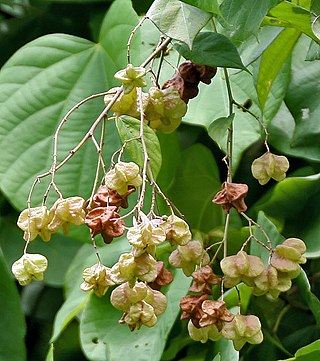
Kleinhovia is a monotypic genus of plants in the cotton, hibiscus and cacao family Malvaceae. The sole species in the genus is Kleinhovia hospita, commonly known as guest tree, an evergreen tree native to Indonesia, Malaysia and other parts of tropical Asia and the Pacific.

Phyllanthus anamalayanus is a species of plant in the family Phyllanthaceae. It is endemic to the Anamalai Hills in Coimbatore district in the state of Tamil Nadu, India. The species is a shrub or small tree occurring in the understorey of mid-elevation tropical wet evergreen forests in the Anamalai Hills, and is endemic to the Western Ghats. It is threatened by habitat loss.

Flindersia brayleyana, commonly known as Queensland maple, maple silkwood or red beech, is a species of tree in the family Rutaceae and is endemic to northern Queensland. It has pinnate leaves with between six and ten leaflets, panicles of white or cream-coloured flowers and smooth fruit that opens in five sections to release winged seeds.

Cuttsia viburnea is a shrub or bushy tree which has toothed leaves and panicles of white flowers, and that is endemic to eastern Australia. It is sometimes called silver-leaved cuttsia, and confusingly also native elderberry, honey bush or native hydrangea. C. viburnea is the only species assigned to the genus Cuttsia.

Elaeocarpus bancroftii, commonly known as Kuranda quandong, Johnstone River almond, ebony heart, grey nut, or nut tree is a large rainforest tree in the family Elaeocarpaceae which is endemic to Queensland. It has coriaceous leaves, attractive white flowers and relatively large fruit containing an edible kernel.

Trochocarpa clarkei, commonly known as lilac berry, is a species of flowering plant in the family Ericaceae. It is a dense, often low-lying shrub with oblong leaves and bisexual flowers arrange in dense flowering spikes, usually on old wood, with maroon and green petals joined at the base to from an urn-shaped to bell-shaped tube with dense tufts of hairs in the throat. The fruit is a bluish-purple drupe.
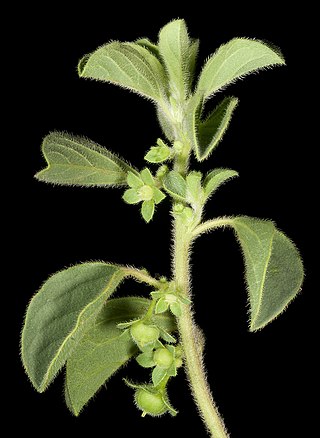
Notoleptopus is a monotypic genus of flowering plants in the family Phyllanthaceae. It is one of eight genera in the tribe Poranthereae. The sole species is Notoleptopus decaisnei. It is a monoecious shrub, native to Australia, New Guinea, and Indonesia.

Xanthosia pilosa, commonly known as woolly xanthosia, is a species of flowering plant in the family Apiaceae and is endemic to south-eastern Australia. It is an erect to open shrub with variably shaped leaves and compound umbels of up to 20 pale green to creamy-white flowers

Phyllanthus reticulatus is a plant species described Jean Louis Marie Poiret; it is included in the family Phyllanthaceae.
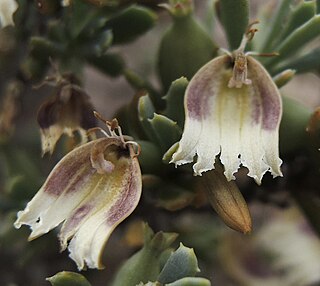
Scaevola collaris is a shrub in the family Goodeniaceae and its native range is five mainland states/territories of Australia: the Northern Territory, New South Wales, South Australia, Queensland and Western Australia.

Phyllanthus calycinus, known as false boronia and snowdrop spurge, is a small shrub in the family Phyllanthaceae, which grows to heights from 20 cm to 1.2 m, often on sandy soils. It is found in both Western Australia and South Australia. In Western Australia its white-cream to pink flowers may be seen from June to January, and in South Australia, from May to October.

Dampiera candicans is a plant in the family Goodeniaceae, native to Western Australia and the Northern Territory.

Teucrium puberulum, commonly known as red berry stick plant, is a species of flowering plant in the family Lamiaceae, and is endemic to inland areas of eastern Australia. It is an erect shrub covered with star-shaped hairs, and with linear to lance-shaped leaves, greenish-white flowers and reddish fruit.

Arabidella is a genus of flowering plants belonging to the family Brassicaceae. It was first described in 1853 by Ferdinand von Mueller as a subgenus of Erysimum to give the name, Erysimum subg. Arabidella, but was elevated to genus status by Otto Eugen Schulz in 1924. The type species is Arabidella trisecta.
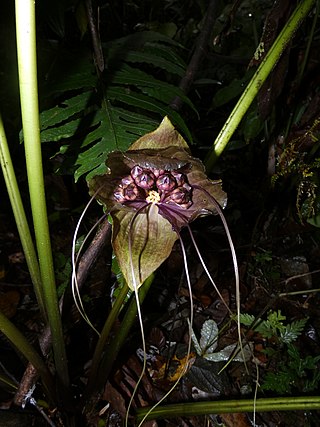
Tacca borneensis is a plant in the Dioscoreaceae family, native to west Borneo.
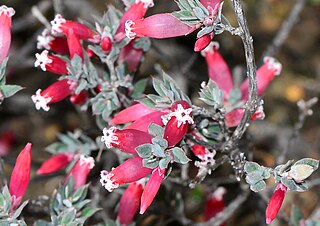
Styphelia stricta is a small plant in the family Ericaceae. It is endemic to Western Australia.

Swainsona stenodonta is a species of flowering plant in the family Fabaceae and is endemic to the north-west of Western Australia. It is an erect annual herb, with imparipinnate leaves with 7 to 13 narrowly linear or oblong leaflets, and racemes of up to 30 or more dark brownish-red to dark purple flowers.
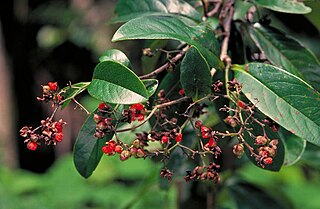
Tetracera daemeliana, commonly known as large-leaved fire vine, is a vine in the guinea flower family Dilleniaceae first described in 1886, which is endemic to the northern half of Queensland, Australia. The flowers are pleasantly perfumed.
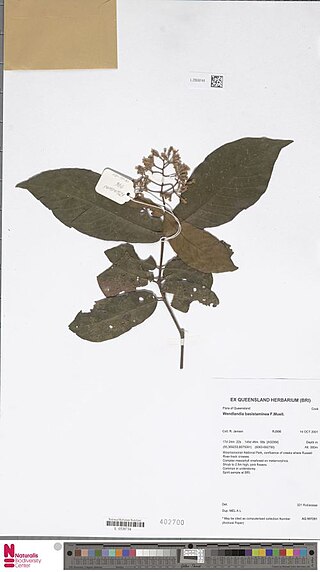
Wendlandia basistaminea is a member of the Rubiaceae family, endemic to Queensland. It was first described by Ferdinand von Mueller in 1892.




















